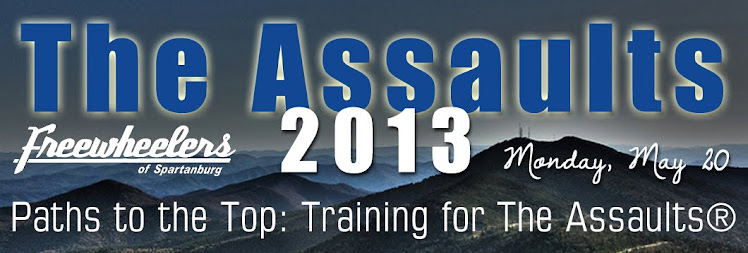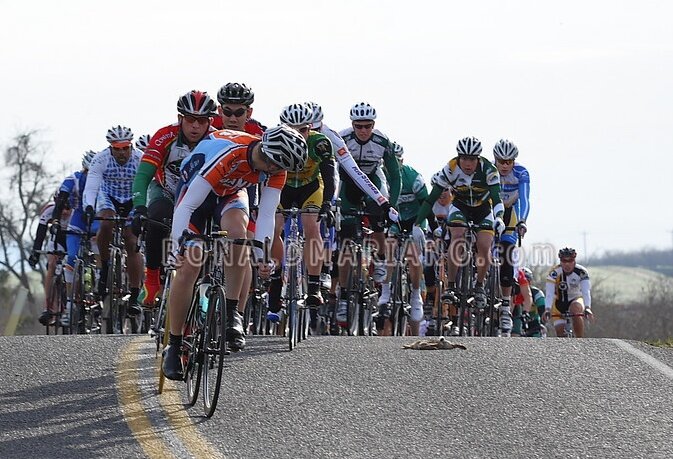This past weekend offered cyclists in the Upstate of SC another unseasonably warm and sunny weekend of riding, but the cost was high winds. Sunday, after a particularly challenging 38-mile ride in a stiff wind, one of the riders talked to me afterward about looking relaxed on the bicycle. I noted that I have been riding seriously for almost thirty years now so I am very relaxed on a bicycle. But remaining relaxed under the stress of high winds and a taxing pace can challenge even the best riders.
What, then, can beginning cyclists do to become efficient, and thus relaxed, cyclists--particularly when targeting a grueling event such as either of the Assaults?
• The most important element in cycling efficiency--riding relaxed--is proper bicycle fit and weight distribution. Many beginning riders are either too upright or leaning far too heavily on the bars. Proper weight distribution should center a rider. Also, many beginning riders are set-up initially with high stems (with a high stack height and the stem sloping upward) and with the hoods/ handlebars tilted upward as well. While this position is intuitively more comfortable at first, the positioning is destined to create squirrelly handling. Beginning riders should work toward a "flat" profile that has the rider "stretched out" as much as is feasible--depending on each rider's physique. A professional fit is important for getting relaxed on the bicycle.
• The next step is obvious--ride a great deal, particularly with groups. Nothing creates relaxed and efficient cycling as much as experience.
• When riding in groups, ride with the upper body relaxed. Concentrate on NOT clenching your hands on the hoods or bar. Many beginning riders expend a great deal of energy through tense upper body muscle groups, resulting in fatigue and poor bicycle handling.
• When riding in groups, ride with the upper body relaxed. Concentrate on NOT clenching your hands on the hoods or bar. Many beginning riders expend a great deal of energy through tense upper body muscle groups, resulting in fatigue and poor bicycle handling.
• Monitor the size gear you are pushing. Many riders get bogged down pushing a bigger gear (large chain ring with the smaller cogs), hoping to maintain speed. All cyclists can learn what the optimal cadence is for you. Traditionally, cyclists should seek a gear you can turn over at 90-100 rpms, but I will confess here, that's never worked for me. I remain a lower cadence cyclist (~85 rpm). The key here is discovering and refining your pedaling efficiency.
• Concentrate on your breathing. Breathing is, obviously, something we do during intense exercise regardless, but many of us have inefficient habits, such as shallow breathing, that negatively impact performance. As someone who struggles with anxiety, I can attest that focusing on deep and proper breathing is a powerful relaxation technique in all aspects of life. Proper breathing while under stress on a ride pays positive dividends over the course of a long ride.
• Monitor your pack/group position. Many beginners sit on the back of packs--even a half-bicycle length or so off the back. Hanging on or off the back is guaranteed to get you dropped. The surges are magnified for the back, and surges are the greatest challenges for beginning riders. Position yourself in the middle or front 2/3 of the pack. Once in the heart of a pack, monitor the wind and find a spot that positions other riders on your side to block cross winds.
• Concentrate on your breathing. Breathing is, obviously, something we do during intense exercise regardless, but many of us have inefficient habits, such as shallow breathing, that negatively impact performance. As someone who struggles with anxiety, I can attest that focusing on deep and proper breathing is a powerful relaxation technique in all aspects of life. Proper breathing while under stress on a ride pays positive dividends over the course of a long ride.
• Monitor your pack/group position. Many beginners sit on the back of packs--even a half-bicycle length or so off the back. Hanging on or off the back is guaranteed to get you dropped. The surges are magnified for the back, and surges are the greatest challenges for beginning riders. Position yourself in the middle or front 2/3 of the pack. Once in the heart of a pack, monitor the wind and find a spot that positions other riders on your side to block cross winds.
• Monitor transition situations--stop signs, turns, railroad crossings--and be sure not to hesitate, not to allow gaps to form as the front riders accelerate while the riders on the back decelerate for the sign, turn, or tracks. Again, if you are sitting in the middle, the transition is far less abrupt as it is on the back.
• Practice and monitor drinking, eating, and adjusting clothing. These are additional disruptions to normal riding that can create gaps beginning riders cannot afford. Skills must be developed on training rides.
• Monitor the pack dynamics. Look for strong and relaxed riders to sit on their wheels. But stronger riders often unconsciously allow gaps to form; for them closing the gap is no problem. But an inattentive beginning rider can get gapped and then dropped when other riders allow gaps to form. Beginning riders should watch and immediately go around gapping riders to keep in the main slipstream of the pack.
The relaxed and efficient rider is created through attention to detail and practice, practice, practice.
Paul Thomas, EdD, Associate Professor
The relaxed and efficient rider is created through attention to detail and practice, practice, practice.
Paul Thomas, EdD, Associate Professor
Furman University
twitter: @plthomasEdD




